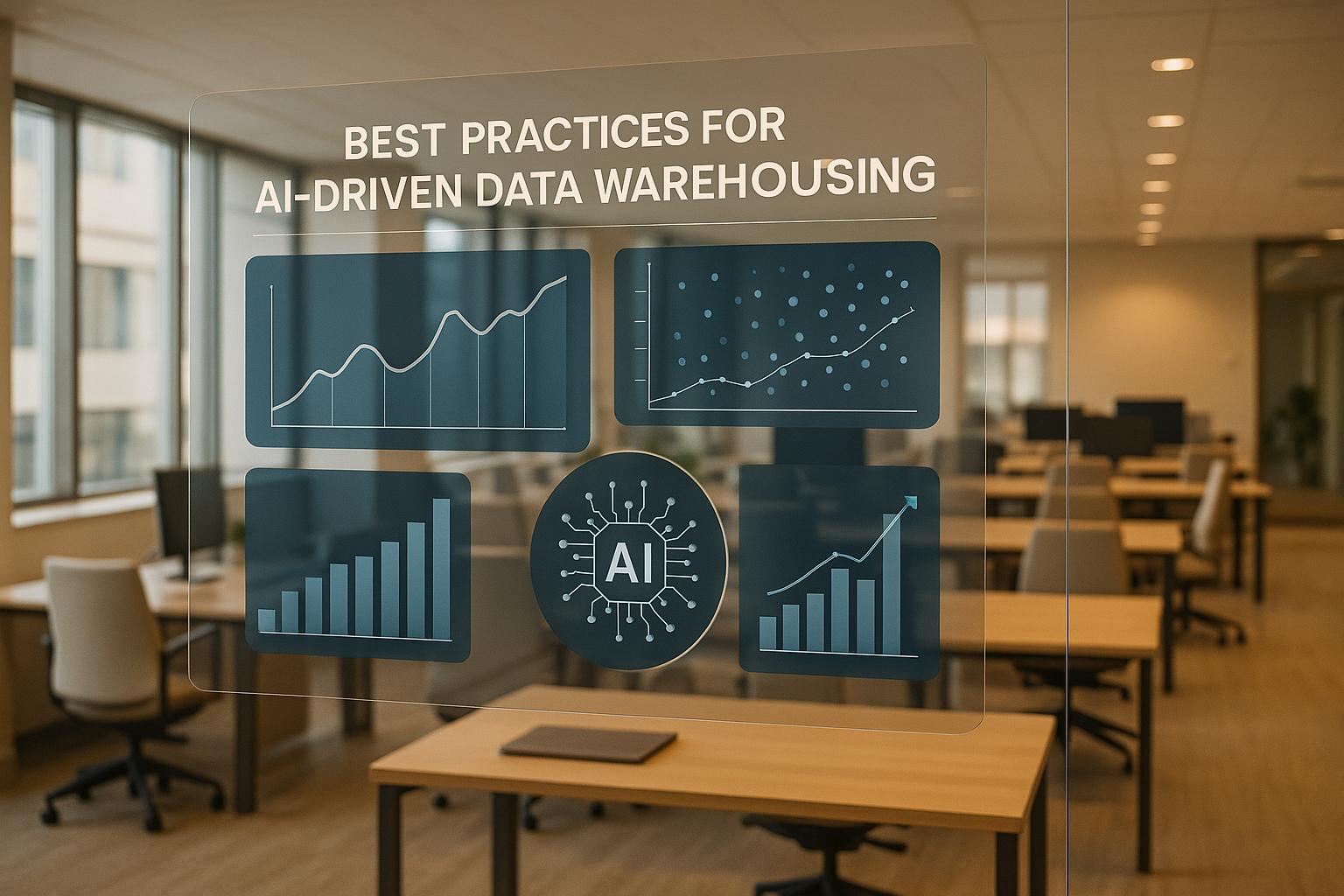AI-driven resource allocation helps businesses manage resources like staff, budgets, and equipment more efficiently using predictive analytics, real-time data, and automation. Here’s what you need to know:
-
Key Technologies:
- Real-Time Data Processing: Adjusts resources instantly to meet current needs.
- Predictive Analytics: Forecasts future resource requirements using past data.
- Automation: Handles repetitive tasks, reducing errors and saving time.
-
Best Practices:
- Set clear goals and metrics to track efficiency.
- Use high-quality, validated data for accurate insights.
- Automate scheduling and routine processes.
- Continuously monitor and adjust resource use in real-time.
- Keep AI models updated and train teams to use them effectively.
AI for Resource Management: How to Optimize Team Efficiency
Core Elements of AI-Driven Resource Allocation
To make the most of AI in resource allocation, businesses need to focus on three key technologies that boost both efficiency and accuracy.
1. Real-Time Data Processing
Real-time data processing helps AI adjust resource distribution on the fly. Here's how it works:
- Tracks how resources are being used across projects
- Spots potential conflicts before they disrupt workflows
- Adapts resource allocation to meet current needs
- Delivers instant insights for better decision-making
While this technology handles immediate demands, predictive analytics takes care of planning for what's ahead.
2. Predictive Analytics for Planning
Predictive analytics uses historical data to anticipate future resource requirements [1][2].
| Component | Function | Impact |
|---|---|---|
| Data Analysis & Forecasting | Identifies trends and predicts needs | Lowers uncertainty and avoids shortages |
| Risk Assessment | Examines potential allocation risks | Reduces disruptions |
Once planning and forecasting are in place, automation ensures everything runs smoothly by handling repetitive tasks efficiently.
3. Automation of Routine Tasks
Automation is a vital part of AI-powered resource allocation [1][2]. It simplifies repetitive tasks, cuts down on manual errors, and ensures allocation rules are consistently applied. This allows teams to focus more on strategic priorities.
Key advantages include:
- Less need for manual input
- Greater accuracy in distributing resources
- Higher team productivity
- Uniform enforcement of allocation policies
Best Practices for AI-Driven Resource Allocation
To make the most of AI in resource allocation, organizations need to follow structured practices that support the core technologies already discussed.
1. Define Clear Goals and Metrics
Set measurable KPIs that focus on improving resource efficiency, such as task completion times, resource utilization rates, and error reductions. These metrics should not only reflect project objectives but also provide clear benchmarks to evaluate the success of AI-powered allocation.
2. Maintain High-Quality Data
Ensure the data used is accurate and consistent by standardizing collection methods, regularly cleaning and validating datasets, and securing storage. High-quality data is essential for effective AI decision-making and accurate resource allocation.
3. Leverage Predictive Analytics
Use predictive analytics to turn historical data into actionable insights for resource planning. This approach can help with:
- Identifying resource needs before projects begin
- Adjusting allocations as new patterns emerge
- Anticipating potential shortages or constraints
- Distributing resources effectively across multiple projects
4. Automate Scheduling Processes
Adopt AI-driven scheduling tools that take into account:
- Team availability and skillsets
- Project deadlines and priorities
- Dependencies between resources
- Historical performance data
While automation can streamline scheduling, human oversight remains crucial to ensure adaptability and address complex scenarios [1].
5. Monitor and Adjust in Real-Time
Use real-time data monitoring systems to track resource use, spot inefficiencies, and make immediate adjustments when needed. Automated alerts can flag potential issues, while regular reviews help refine allocation strategies over time [2].
"Predictive analytics enables proactive resource allocation, reducing the risk of shortages or excess resources, while optimizing resource use to meet future demands" [2].
sbb-itb-bec6a7e
Maintaining and Improving AI Models
1. Regular Updates for AI Models
Keeping AI models up to date is crucial for achieving better performance in resource allocation. Organizations should:
- Incorporate fresh data and test updated models against historical outcomes before putting them into use.
- Ensure the models are validated thoroughly with past data to confirm reliability.
Research shows that organizations updating their AI models frequently experience a 20-30% reduction in project timelines and a 15-25% cut in costs [2]. These gains come from models that can better adjust to evolving business needs and resource demands.
"AI-driven resource allocation requires continuous updates for optimal performance." - Eyer.ai [2]
Still, updated models alone won't drive success - teams must also be trained to use these tools effectively.
2. Equip Teams for AI Integration
To maximize the potential of updated AI models, teams need training to understand and apply AI insights. This training should focus on three main areas:
| Training Focus | Purpose | Expected Outcomes |
|---|---|---|
| Data Interpretation | Teach teams to analyze and apply AI insights | Better decision-making using predictive analytics |
| System Operation | Provide hands-on knowledge of AI tools | Smoother daily operations with fewer errors |
| Change Management | Help teams adapt to new workflows | Quicker adoption and reduced resistance |
Regular workshops and training sessions are key to ensuring team members can:
- Understand analytics reports and resource trends for planning.
- Make informed decisions based on AI-driven recommendations.
- Spot potential issues that may need human intervention.
To ensure success, organizations should set clear performance metrics, such as measuring task completion times, error rates, and resource efficiency. Regularly reviewing these metrics helps fine-tune AI-driven processes for continuous improvement [2].
Conclusion: Efficiency Gains with AI-Driven Resource Allocation
AI-powered resource allocation is reshaping how organizations operate, offering measurable improvements in several critical areas:
| Area | Impact | Measurable Benefits |
|---|---|---|
| Operational Efficiency | Automating routine tasks and enabling real-time adjustments | Less manual effort, quicker decisions |
| Resource Optimization | Data-driven allocation and predictive planning | Better use of resources, reduced waste |
| Performance Tracking | Continuous monitoring and analytics | Higher productivity, better ROI |
By following the practices discussed earlier, organizations can streamline operations through automation, predictive planning, and real-time adjustments. These advancements are especially beneficial for smaller organizations looking to make the most of limited resources.
With predictive analytics and automated scheduling, businesses can foresee resource needs and make proactive adjustments, ensuring that resources are distributed effectively across projects [2][3].
To maximize these benefits, it's essential to balance AI's capabilities with human oversight. Success depends on factors like maintaining high-quality data, updating AI models regularly, and providing thorough training for teams [1][3].
Platforms such as AI for Businesses offer tailored tools to help SMEs and scaling companies shift from traditional methods to data-driven strategies, improving overall efficiency.
Additional Resources
Here are some tools and platforms that can help businesses implement AI-based resource allocation effectively:
AI for Businesses

This platform offers a range of AI tools tailored for small and medium-sized enterprises (SMEs). It provides both free and paid options for automation, design, and document processing, helping businesses simplify and enhance their operations.
When choosing AI tools for resource allocation, keep the following factors in mind:
| Factor | Why It Matters |
|---|---|
| Data Integration | Ensures smooth compatibility with existing systems |
| Scalability | Handles growth and evolving business requirements |
| Real-time Processing | Allows instant adjustments to resources |
| User Training Support | Helps teams adopt and use the tools effectively |
These tools align with the AI strategies mentioned earlier, enabling businesses to automate tasks like scheduling, improve how data flows between systems, and monitor resources more efficiently. The platform also provides case studies and step-by-step guides to assist businesses of all sizes with successful AI integration.
FAQs
How can AI assist in resource allocation?
AI uses historical data, real-time insights, and predictive analytics to manage resources more efficiently. Here's a quick breakdown of what to focus on:
| Aspect | Key Focus Areas |
|---|---|
| Data Needs | Past project data, resource availability, team skills |
| Core Features | Real-time tracking, predictive tools, automated schedules |
| Performance Goals | Faster response times, higher task completion rates, better productivity |
What are the business advantages of AI in resource allocation?
AI helps businesses streamline operations, cut costs, and make smarter decisions. Some specific advantages include:
- Smarter resource distribution driven by data
- Less waste and better use of available resources
- Faster adjustments to meet real-time project needs [1][2]
What steps are essential for successful AI implementation?
For a smooth AI rollout:
- Ensure your data is accurate and consistent
- Provide staff training on how to use AI tools
- Continuously monitor results and tweak strategies as needed [2][3]
If you're just starting out, set clear goals and track progress with specific metrics. Begin small and gradually expand your automation efforts [2][3].
To explore more tools and strategies for AI integration, platforms like AI for Businesses can provide valuable guidance. By addressing these points, companies can better navigate AI-driven resource allocation.


